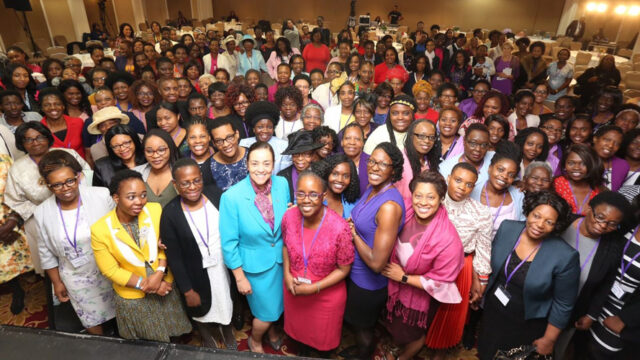Experiencing God’s presence

Many Adventists may wonder about the significance of the sanctuary message, especially in the troubling times we are currently experiencing.¹ In this we must rely on God Himself who points us repeatedly to this important biblical doctrine and summarizes the main point of the sanctuary message when instructing Moses to build a sanctuary: “Let them make me a sanctuary, that I may dwell in their midst” (Ex. 25:8, ESV).² God wants to reside with His people and have intimate fellowship with them! The sanctuary doctrine is the unfolding of the Immanuel experience embodied in Jesus—“God with us” (Isa. 7:14; Matt. 1:23).
MIND STRETCHING: INTO THE PRE-FALL HEAVENLY SANCTUARY
After instructing Moses to build a sanctuary (Ex. 25:8), God adds in the very next breath, “Make this tabernacle and all its furnishings exactly like the pattern I will show you” (verse 9, NIV). The Hebrew term for “pattern” implies that the resplendent earthly sanctuary was to be a copy (albeit only a faint reflection) of the vast and glorious heavenly original (compare Heb. 8:3-5).
According to Jeremiah 17:12 the heavenly sanctuary existed “from the beginning.” Before his fall the angel Lucifer served as “covering cherub” in the heavenly sanctuary, “in Eden, the garden of God,” “on the holy mountain of God” (Eze. 28:13, 14), also called the “mount of the congregation [or assembly]” (Isa. 14:13). Before functioning to deal with the sin problem, the heavenly sanctuary was a place where the inhabitants of the universe “assembled” as a congregation to worship and praise their Maker. In theological terms: “Before soteriology [salvation] was doxology [praise]!” Throughout Scripture this heavenly temple is portrayed as alive with praise, worship, and adoration offered to the King of kings, even in the midst of solving the sin problem (see, e.g., Isa. 6:1-8; Ps. 150:1; Rev. 4:8-11; 5:9-14).
The heavenly sanctuary in the Old Testament is often spoken of as a “temple” (see, e.g., Ps. 11:4; Isa. 6:1), that is, the residence of a deity. It’s described as God’s “habitation” or “dwelling” (e.g., Deut. 26:15; Ps. 68:5). Although the heavenly sanctuary indeed has a “throne room” (the most holy place), where the Ruler of the universe conducts the “affairs of state” and meets with His heavenly council (e.g., 1 Kings 22:19; Job 1:6), it functions primarily as God’s abiding place, His personal residence—His home. Visualize its furnishings—a table for food, a lampstand, sweet-smelling incense, an ark throne/ footstool (see Rev. 4:5; 8:3; 11:19; cf. Rev. 19:9)—all are normal elements one would expect in a royal palace. We need to experience the warm, “homey” atmosphere of the heavenly sanctuary. Scripture portrays a personal Creator who comes down in space and time to reside among His unfallen intelligences in the universe. This biblical picture is a corrective to major Christian theological systems constructed around the platonic notion of a timeless God who is not compatible with space-time reality. We have the privilege of calling the world back to the biblical view of God as one who experiences intimate relationship with His creatures and invites them to His palace home for intimate fellowship.
EARTH’S FIRST SANCTUARIES
It was noted earlier that the original heavenly sanctuary was located “in Eden, the Garden of God” (Eze. 28:13). When God created this earth, He again planted “a garden . . . in Eden” (Gen. 2:8). The use of similar terminology intimates that the earthly Eden was a copy of the heavenly Eden sanctuary. Numerous links between Genesis 1-3 and other sanctuaries in Scripture support the conclusion that the pre-Fall Garden of Eden (or at least parts of it) served as the original sanctuary on earth.³ To this garden sanctuary God came “walking . . . in the cool of the day” (Gen. 3:8), seeking intimate fellowship with Adam and Eve. Here He spent 24 golden hours communing with them every Sabbath, making the Sabbath holy by His presence (Gen. 2:1-3).
But there was an enemy lurking in the garden sanctuary. Lucifer, the fallen cherub (now called Satan), had been cast out of heaven after his rebellion (Rev. 12:9), and at the tree of the knowledge of good and evil he channeled his lies about God through the serpent to Eve. Tragically, Adam and Eve believed these lies instead of the word of God and ate the fruit of the forbidden tree. The floodgates of woe were poured out upon this world. When God came walking in the cool of the day, instead of rejoicing in His fellowship, the couple hid in fear, guilt, and shame, and tried to cover their nakedness by the fig leaves of their own works. But God did not forsake them. In love He came searching for them.
THE SANCTUARY ATONEMENT DRAMA UNVEILED
In the earthly Eden sanctuary, after Adam and Eve sinned, God unveiled to them the great drama of atonement (“at-one-ment”) that was to unfold in three great sanctuary acts in the life and ministry of the coming Messiah. These three acts of the atonement drama are foundational for the sanctuary message throughout Scripture with regard to solving the sin problem, although not always presented in the same order. In post-Fall Eden, God comes as judge, conducting the first “investigative judgment” in history. Adam and Eve’s testimony of excuses and accusations against God make evident their crime of high treason against their Maker (Gen. 3:9-14), deserving of the just penalty of death (Gen. 2:17).
But the unimaginable then happens! The guilty pair “look into [their] Judge’s face and see a Savior there.”⁴ The second great act of the sanctuary atonement drama is announced: the messianic Seed will die as their substitute (Gen. 3:15). “The instant man accepted the temptations of Satan, . . . Christ, the Son of God, stood between the living and the dead, saying, ‘Let the punishment fall on Me. I will stand in man’s place.’ ”⁵ There was a death that very day—an animal was sacrificed to prefigure the future substitutionary death of the Messiah (verse 21).
Priestly mediation, the third great at-one-ment act of the sanctuary drama, is also intimated in these two verses. God promises to mediate grace by putting a supernatural enmity toward the serpent (hatred of sin) in their hearts (verse 15), and He intercedes for them by covering their “nakedness” (not only physical, but consciousness of guilt and shame) with the robe of His righteousness (verse 21; cf. Isa. 61:10).
Even though Adam and Eve could no longer remain in the garden sanctuary, the presence of God, His Shekinah glory, was accessible at the “sanctuary” altar located outside the garden at its eastern gate, and God still came close to communicate with His erring children (Gen. 3:24; 4:3-7). Throughout the patriarchal era God often met and communed with His faithful servants where they constructed their sanctuary altars (e.g., Gen. 22:1-19; 28).
THE WILDERNESS TABERNACLE
What is intimated in the earthly Eden sanctuary after the fall of Adam and Eve is made clearer in the precincts and services of the wilderness tabernacle. The Mosaic sanctuary services provided real atonement but anticipating God’s greater atonement (“at-one-ment”) for repentant Israelites in the wilderness, in view of what Jesus Christ would later achieve during His incarnation and heavenly ministry. They also prefigured the plan of salvation. The Bible calls these prefigurations “types.” Biblical “types” (Greek, typos) are (usually Old Testament) persons, events, and institutions (such as the sanctuary) that have been used by God to help us anticipate the fulfillment as it came in Jesus (“the antitype”).
The sanctuary and its services foreshadowed what Jesus would accomplish in His three acts of the atonement drama: substitutionary sacrifice, priestly mediation, and investigative/executive judgment. The first two acts are represented by the two altars in the courtyard and holy place respectively: one of “continual atonement” and the other of “perpetual intercession” (Ex. 27:1-8; 30:1-10). Blood and incense are both symbols of sacrifice and mediation. The animal sacrifices prefigured Christ’s death as a substitute for sinful humans. The incense offered up by the priest on the altar of incense represented Christ’s merits (or righteousness), which as high priest and mediator He imputes to the believing sinner.
The third act of the atonement drama took place on the Day of [Ultimate] Atonement (yom hakippurim) at the end of the Hebrew religious year, typifying the last-day judgment. Throughout the year repentant sinners had experienced at-one-ment with God through the sin offerings, but the sanctuary was defiled by the record of those sins transferred to its precincts (Lev. 4). This transfer of forgiven sins to the sanctuary, God’s residence, signified that God had taken upon Himself the responsibility for these confessed sins.
On the Day of Atonement (Lev. 16) the high priest sprinkled the sin-free blood of the Lord’s goat in the most holy and holy places and on the altar, and cleansed the sanctuary. This foreshadowed the vindication of God as He demonstrates His justice in forgiving repentant sinners through the blood of Jesus’ sacrifice. The Day of Atonement is a day of cosmic investigative judgment (Lev. 16:29, 31; 23:27-32) as the holy fruits of God’s people affirm before the onlooking universe that their faith in the atoning work of Christ is genuine.
THE SANCTUARY IN DANIEL 7-9
The prophecies of Daniel 7-9 coincide with the three acts of the sanctuary at-one-ment drama, providing the timing of the atoning activities of the Messiah, ordered from effect to cause (as is common in Hebrew thought). We reverse the order here to fit Western cause-to-effect logic. Daniel 9 highlights the Messiah’s sacrifice, providing the prophetic timing of the Messiah’s substitutionary death, coming in the midst of the seventieth week of the 70-week prophecy, which, calculated according to the day-for-a-year principle implicit in the text, yields A.D. 31 (verses 24-27).
Daniel 8 focuses upon the priestly mediatorial ministry of Christ in the heavenly sanctuary after His ascension. It reveals the time for the commencement of the antitypical (i.e., the fulfillment of the type) day of atonement, when the heavenly sanctuary would begin to be “restored/cleansed/ vindicated” (Hebrew, nitsdaq, verse 14) at the end of 2,300 days (years). This period began at the same time as the 70-week prophecy, 457 B.C., and ended on October 22, 1844, when the special nitsdaq work of Christ, our high priest, began in the heavenly sanctuary.⁶
Daniel 7 makes clear that this antitypical day of atonement is a time of judgment, in which God condemns the little horn power but gives a verdict “in favor of the saints” (verse 22). The judgment is good news for God’s people: God is not only with us, but for us!
SANCTUARY TYPOLOGY IN THE BOOK OF HEBREWS
The central chapters of Hebrews (7-10) provide the most comprehensive biblical description of the fulfillment of sanctuary symbols in the three acts of the atoning ministry of Jesus. First, Christ’s once-for-all sacrificial death is presented as the antitypical fulfillment of the entire Old Testament sacrificial system (Heb. 10:1-4, 11, 12; 9:13, 25, 26). Second, when Christ entered the heavenly sanctuary at His ascension, He entered to inaugurate it, to officially start up the services as priest-king, to begin his high-priestly mediatorial (tamid) holy place ministry: “He ever lives to make intercession for them” who come to God through Him (Heb. 7:25; cf. Heb. 10:20).
Third, from the point of view of the apostle in the first century A.D., the day of atonement work of judgment was still in the future: “And as it is appointed for men to die once, but after this the judgment, so Christ was offered once to bear the sins of many. To those who eagerly wait for Him He will appear a second time, apart from sin, for salvation” (Heb. 9:27, 28; cf. Heb. 10:26, 31).
The book of Hebrews not only describes Christ’s activities in the atonement drama; it also uniquely emphasizes what God invites His people to experience during this time! Four times the author of Hebrews invites His people to come to the heavenly sanctuary: to “come boldly to the throne of grace” (Heb. 4:16); to enter “the Presence behind the veil, where the forerunner has entered for us, even Jesus” (Heb. 6:19, 20); to “have boldness to enter the [heavenly] sanctuary through the blood of Jesus” (Heb. 10:19, HCSB);⁷ and to realize that “you have come to Mount Zion and to the city of the living God, the heavenly The earthly Eden was a copy of the heavenly Eden sanctuary. Jerusalem, . . . to Jesus the Mediator of the new covenant” (Heb. 12:22-24). God not only invites us to come occasionally by faith to the heavenly sanctuary; we are invited to sanctuary life, continually experiencing by faith the glorious presence of God in His heavenly sanctuary.
THE BOOK OF REVELATION
The book of Revelation is saturated with sanctuary language and is structured by seven scenes into the sanctuary. In these passages is embedded the same three-act sanctuary at-one-ment drama as found elsewhere in Scripture. The sacrifice of Christ is emphasized in chapters 1-3. His tamid mediatorial work is highlighted in chapters 4-8. The final judgment (antitypical day of atonement) is the subject of Revelation 10-20, including the pre-Advent investigative judgment (Rev. 11:1, 2, 19; 14:6, 7), the review judgment during the millennium (Rev. 20:4) and final executive judgment upon the wicked (verses 11-15).
A special contribution of Revelation to the sanctuary message is the “big picture” of the sanctuary throughout eternity after the end of the cosmic conflict, demonstrating the Immanuel experience—“God with us.” You may be wondering why the heavenly sanctuary may be needed once the plan of redemption has been successfully carried out. But follow me on this: Revelation 21:22 is used to support this view, where John records his vision of the New Jerusalem after the end of sin and sinners: “I saw no temple in it, for the Lord God Almighty and the Lamb are its temple.” John does not say that there will be no more heavenly sanctuary/temple! This would contradict Revelation 7:15, where John specifically states that the redeemed 144,000, after the end of sin and sinners, “are before the throne of God, and serve Him day and night in His temple.” Rather, in Revelation 21:22 John says that he does not see a temple in the city.
He adds that the Lord God Almighty and the Lamb are the true temple. This has alway been true. Ultimately the temple is where God is; His presence comprises the ultimate temple. But I think this does not necessarily do away with the existence of a temple in space and time where God dwells with His people, any more than the glory of God and the light of the Lamb do away with the sun and moon (see Rev. 21:23; 22:1; Isa. 30:26; 66:23).
In Revelation 21:2, 3 John describes the descent of the New Jerusalem out of heaven to this earth, and then records the explanation of that vision proclaimed by a loud heavenly voice: “Behold, the tabernacle of God is with men; and He will dwell with them, and they shall be His people, and God Himself will be with them and be their God.” The New Jerusalem is identified as the “tabernacle of God.” The Greek word for “tabernacle” is skēnē, the same term used in the Greek translation of the Old Testament (the Septuagint) for the sanctuary. John did not see a temple in the city, because the whole city was now God’s sanctuary.
This interpretation finds even more support later in the same chapter: the angel measures the dimensions of the city, and John gives the summary: “Its length, breadth, and height are equal”—the shape of a cube (Rev. 21:16). The only item mentioned elsewhere in Scripture in the shape of a cube is the most holy place of the sanctuary. I think the New Jerusalem is the tabernacle/sanctuary of the new earth; more exactly, it is the most holy place, with the ultimate Sanctuary—the Lord God Almighty and the Lamb—in its center.
The sanctuary of the new earth— the New Jerusalem—continues the heavenly sanctuary’s original function of doxology, as the place where the saints serve in the Father’s presence and the whole universe comes to worship and praise the King of kings and Lord of lords (notice the 14 doxologies scattered throughout the book). Revelation 21-22 describes life in the New Jerusalem in language referring to the Hebrew Feast of Tabernacles (see Lev. 23:33-43). The earth made new will be an eternal festival worship celebration of the Immanuel experience—the Lord God Almighty and the Lamb with us in the sanctuary.
GOD’S ETERNAL HOME—AND OURS
John 14:2, 3 records Jesus’ promise to return a second time: “In My Father’s house are many mansions. . . . I go to prepare a place for you. And if I go and prepare a place for you, I will come again and receive you to Myself; that where I am, there you may be also.” “In My Father’s house . . .” What is the Father’s “house”? In light of what we have seen elsewhere in Scripture, the Father’s house in heaven is the heavenly sanctuary. Jesus is going to prepare “mansions”—the Greek literally says “rooms”—in the Father’s house. Even after the New Jerusalem descends to this earth following the millennium, our “city home” will be a mansion-like “room” in the most holy place of the sanctuary. God is actually inviting us to take up residence with Him for eternity in His home. The Immanuel experience will never end—experiencing God’s intimate presence in His sanctuary/temple forever. Maranatha—come soon, Lord Jesus! We can hardly wait!
¹ For further discussion, see Richard M. Davidson, A Song for the Sanctuary: Experiencing God’s Presence in Shadow and Reality (Silver Spring, Md.: Biblical Research Institute; Nampa, Idaho: Pacific Press Pub. Assn., 2022).
² Scripture quotations marked ESV are from The Holy Bible, English Standard Version, copyright © 2001 by Crossway Bibles, a division of Good News Publishers. Used by permission. All rights reserved.
³ See Richard M. Davidson, “Earth’s First Sanctuary: Genesis 1-3 and Parallel Creation Accounts,” Andrews University Seminary Studies 53, no. 1 (2015): 65-89.
⁴ “Jubilee,” performed by Michael Card, written by Randy Lynn Scruggs and Michael Card, Sparrow Records, 1989.
⁵ The Seventh-day Adventist Bible Commentary, Ellen G. White Comments, vol. 1, p. 1085.
⁶ Seventh-day Adventists believe that the 2,300-day prophecy associated with the cleansing of the sanctuary and described in Daniel 8:14 spans the significant period that begins in the Medo-Persian Empire (starting in 457 B.C. with the rebuilding of Jerusalem’s wall, based on Dan. 9:24-25) and ends in A.D. 1844 with the cleansing of the heavenly sanctuary and Christ’s end-time work of judgment. For a more detailed discussion see Ángel Manuel Rodríguez et al., ed., Andrews Bible Commentary (Berrien Springs, Mich.: Andrews University Press, 2020), pp. 1036-1047.
⁷ Texts credited to HCSB are taken from the Holman Christian Standard Bible, copyright © 1999, 2000, 2002, 2003, 2009 by Holman Bible Publishers. Used by permission.








